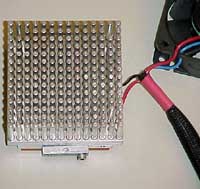Swiftech MC370 Socket-370 Peltier Cooler
by Anand Lal Shimpi on December 22, 1999 2:23 AM EST- Posted in
- Cases/Cooling/PSUs
The Peltier Effect
As we mentioned in our review of the MC1000, the Peltier Effect is the basis for the Swiftech line of coolers and was discovered by Jean C. Peltier in 1834. The "Peltier" principle basically states that when electrical current flows through two dissimilar conductors, heat transfer will occur from the "cold junction" to the "hot junction". The simple illustration below illustrates the Peltier Effect in action.

The Peltier effect is taken advantage of with the MC370 by what is known as its thermo-electric cooling (TEC), or more commonly known as the Peltier. The problem with the Peltier Effect is that, although one side of the TEC gets very cold, the other side becomes very hot courtesy of the transfer of heat from the "cold junction" to the "hot junction." This is exactly why Peltier coolers are not widely used, they simply generate too much heat and thus must be used with a very efficient heatsink and a powerful fan in order to remove the heat generated by the hot side of the TEC.
Swiftech gets around this problem by using a very efficient heatsink in combination with a very powerful 60 mm fan capable of moving 33 cubic feet of air per minute (cfm).
With the MC1000, removing the heat generated by its 72W TEC was easily done by the large 5" x 2.5" heatsink and two 60cm 33 cfm fans. With the MC370, or any Socket-370 cooler for that matter, you have a significantly reduced work area to perform the cooling in, and especially when dissipating the heat generated by a Peltier, a heatsink with a large surface area is greatly desired.
Basically, Swiftech was placed in the position of needing to live up to the standards they brought upon themselves with the MC1000 and the insane MC2000 had yet to accomplish that with a heatsink that was physically only half the size of the MC1000. A very difficult task indeed.











0 Comments
View All Comments